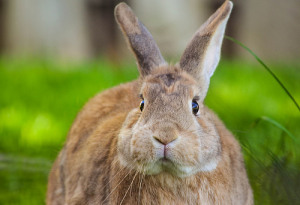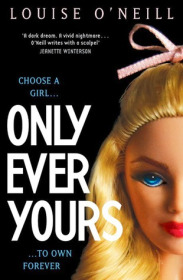With Easter Sunday nearly upon us, it’s probably time we talk about rabbits. I have a complicated relationship with these admittedly adorable creatures. My first favorite stuffed animal was a floppy-eared bunny I received at Easter. My youngest son, too, has a stuffed bunny that is near and dear to his heart, enough so that when he was younger, there were many nights of frantic searching for “Bunny,” who always managed to disappear at bedtime leaving behind one inconsolable little boy.
 Just look at that twitchy nose. He’s up to something. photo credit: emraps my kid’s face via photopin (license)
Just look at that twitchy nose. He’s up to something. photo credit: emraps my kid’s face via photopin (license)
And then there’s the Easter Bunny, one of a very few species of mammals to lay eggs, and the only one known to lay eggs filled with candy. This creature is also commonly classified as a rarely seen and likely nonexistent animal (like Big Foot), a creeper sent to spy on naughty children (like the elf on the shelf), or a guy in a scary costume that makes small children cry in the middle of the mall commons (like our favorite jolly fat man).
But where does this strange critter come from? The answer to that may be as hard to find as a favorite stuffed bunny at bedtime (make sure you check outside in the wet grass next to the play set). There are references to the Easter Bunny as early as the 16th century in Germany where it seems likely the tradition was born.
 The only bunny I’ve ever liked.
The only bunny I’ve ever liked.
And speculation that rabbits and hares became linked to the holiday because they are the animals most closely associated with the pagan goddess Ostara, traces its roots back to the connection of the goddess with the Christian holiday. That connection was first postulated by the 8th century monk and (practical) historian known as the Venerable Bede, who a lot of scholars now think probably just kind of made it up.
That didn’t stop Jacob Grimm (of fairytale-telling fame) from spreading the rumor in 1835, nor does it slow the annual onslaught of internet claims that Easter is little more than the Christian commandeering of yet another pagan holiday (which, even according to quite a few pagan scholars, it’s not).
But that still doesn’t explain why a bunny brings a basket of eggs, a common symbol of fertility and new life, to hide for the kiddos on Easter. All we really know is that the tradition seems to come out of German Lutheranism in various forms, all involving the hiding of colored eggs by an animal. The species of the egg-bearer varied by region, showing up sometimes as a rabbit, but in other places as a rooster, a cuckoo, a stork, or a fox. Eventually the rabbit won the day. By the time German immigrants began arriving in large numbers in America in the 1700s, they brought the Easter Bunny with them.
 Well, I’m fond of this one, too. Now that my son is getting older, it doesn’t hippity hop through my yard much anymore, but I didn’t really mind. Except at bedtime.
Well, I’m fond of this one, too. Now that my son is getting older, it doesn’t hippity hop through my yard much anymore, but I didn’t really mind. Except at bedtime.
But as I mentioned at the beginning of this post, I have a complicated relationship with bunnies. On the one hand, they are adorable. And on the other hand, I hate them. Because while the Easter Bunny brings candy, plain ol’ bunnies hippity hop through my neighborhood with impunity.
These monstrous little nose-wigglers descend every spring to destroy my carrot, beet, and lettuce crops, decimate my blueberry bushes, and even nibble the life out of the new little tree shoots that have done nothing to deserve this harsh treatment. The demons dig ankle-spraining holes in my yard (never once having the decency to leave a candy-filled egg inside) and relentlessly taunt my dog who is well-intentioned, but too slow to catch them.
 My poor dog would like to add another argument against the Easter Bunny.
My poor dog would like to add another argument against the Easter Bunny.
So here’s my proposal. Let’s go back to the Easter Fox. Foxes are shy enough you rarely see them. They’re also kind of cute, but much easier to say no to when your son begs for one as a pet, and they will pretty much leave your beet crop untouched. Also, in the wild, though foxes do not lay eggs (and neither do bunnies, in case you weren’t clear on that), they do tend to steal and occasionally hide them. Also (and I think it’s safe to say this is the most important point) adopting the fox as the official mascot of Easter would effectively put an end to all this “Hoppy Easter” nonsense.
So it just makes sense. Or at least it makes as much sense as the Easter Bunny.
Advertisements Share this:- More






